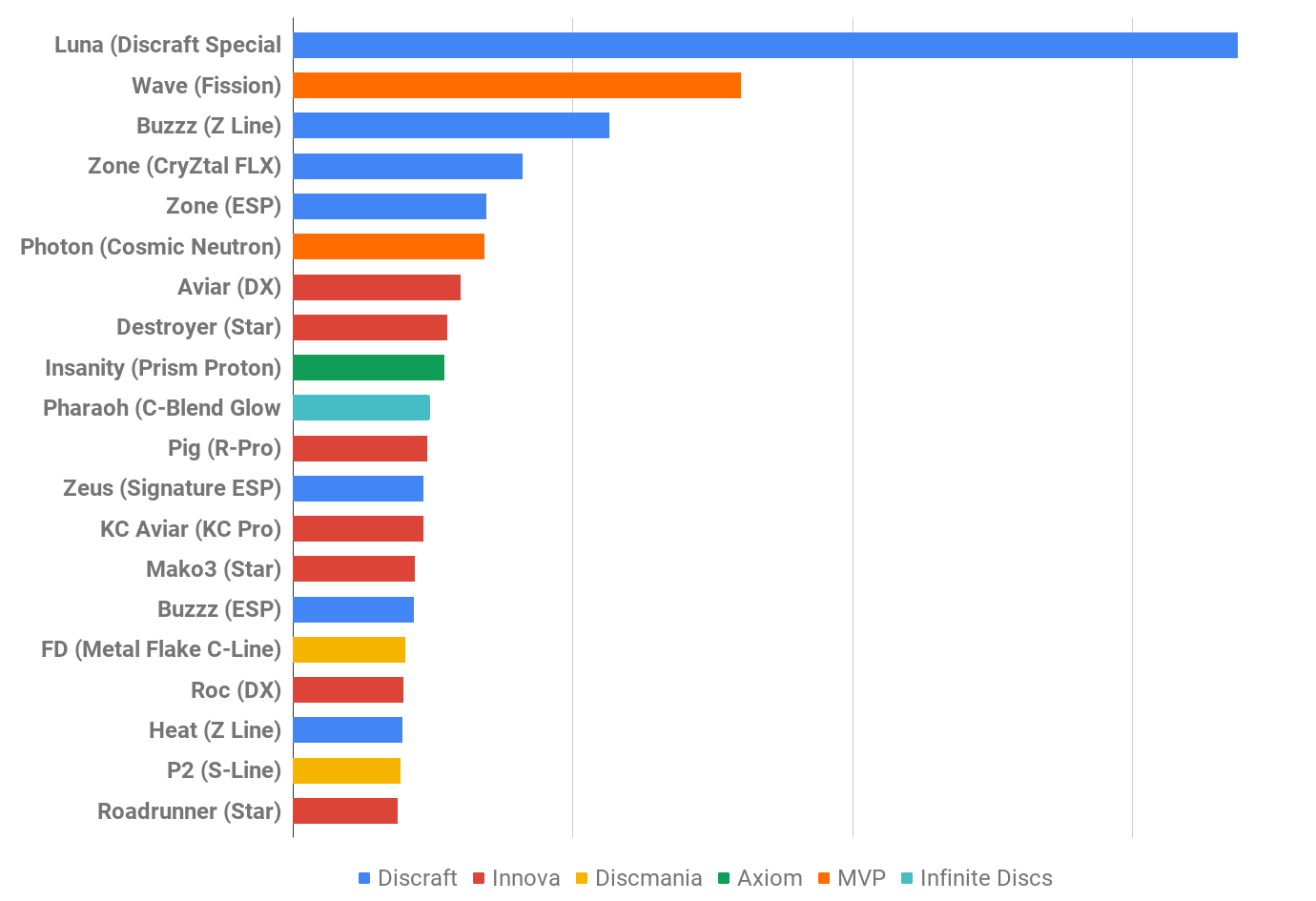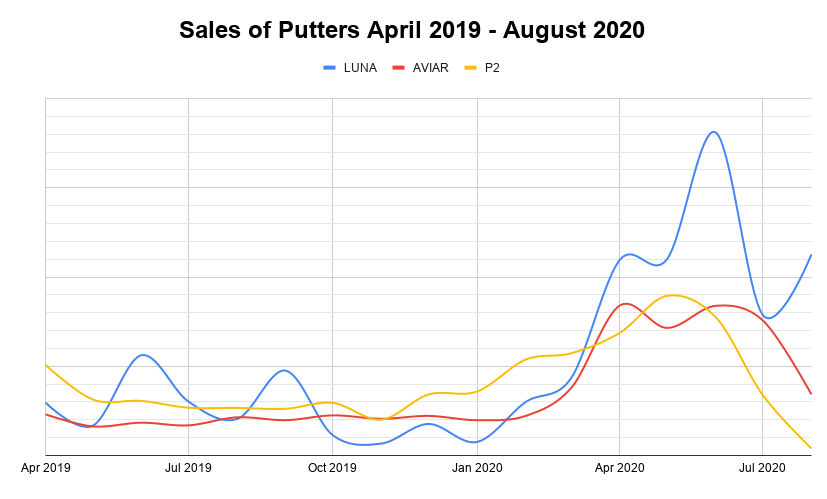This week we will continue to examine the sales numbers and ratings to determine the best distance drivers for 2020. Last week we looked at all drivers, (check out those results here) but this week we will narrow the criteria and limit the candidates to speed 10 and higher discs. And like last week we will look at the sales numbers and the user submitted ratings to determine which distance driver is the best. Then we will consider your votes for a week, and declare the winner.
Best Disc Golf Distance Drivers
Despite taking the number 2 spot in the fan voting, the Destroyer maintained the number one spot, taking first in sales and ratings. According to O’Connor G., “Destroyer is number 1 for a good reason! I love the variation in the flight patterns of the different molds. You can bag 5 destroyers that all feel the same in the hand (a good size for my hand as well) but have drastically different flights.”
How We Chose the Best Disc Golf Driver For 2020?
There are several different components to our rating system that we used to determine the best disc golf distance drivers for 2020:
- First, we counted the sales volume and made a list of the top sellers of 2020.
- Second we look at both how you have rated the discs, and how many reviews you have made for the top drivers to date on Infinite Discs website. A high rating and a lot of reviews translates into a desirable disc.
- And finally, we considered what you our blog readers and social media followers said when asked the question: What do you think is the best disc golf driver?
In The Beginning
When I started playing disc golf, I did what so many of us did before we understood the flight numbers on the discs, I went for the high speed discs. “Super Long Distance Driver”? Yes, please! “High Speed Driver”? Of course I want my disc to fly fast! It was as if we expected our drivers to jump out of our hands the moment we quit holding them tight.
Most of us have since come to understand that higher speeds mean that we have to be able to throw faster in order for them to fly the way they were designed. Although that may limit the speed of the disc that we choose, with a variety of lighter weight plastic types available today, even less experienced players can generate enough speed to be able to throw the faster discs. That creates a much larger audience for higher speed discs. Today we are going to take a look at how that audience fills their bags with those long distance drivers.
Best Disc Golf Distance Drivers by Sales
We already know from last week’s blog about several of the top high speed drivers. Since they made the list for the best overall drivers, obviously they are going to make the list for the best high speed drivers. Those include the Innova Destroyer and Wraith, the Discraft Zeus and Hades, and the Infinite Discs Emperor and Pharaoh.
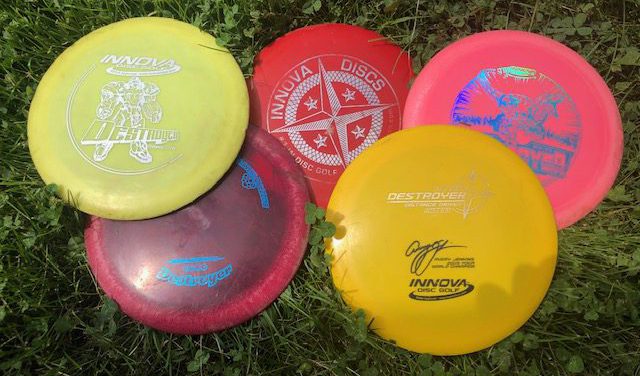
Also like last week, there are a few discs that made the list for top sales, but not for the top ten in reviews. And a couple that made the top ten for reviews, but not the top ten for sales. Let’s start by looking at the top selling distance drivers for 2020:
| 2020 Sales Rank |
Disc Mold |
| 1 |
Innova Destroyer |
| 2 |
Innova Wraith |
| 3 |
Discraft Hades |
| 4 |
Discraft Zeus |
| 5 |
Innova Beast |
| 6 |
Discraft Force |
| 7 |
Innova Shryke |
| 8 |
Infinite Discs Pharaoh |
| 9 |
Discraft Avenger SS |
| 10 |
Infinite Discs Emperor |
| 11 |
Discraft Thrasher |
| 12 |
Innova Boss |
| 13 |
Innova Mamba |
| 14 |
Innova Tern |
| 15 |
Discraft Nuke |
| 16 |
Infinite Discs Aztec |
| 17 |
Innova Katana |
| 18 |
Inova Corvette |
| 19 |
Discraft Crank |
| 20 |
Nuke SS |
The Best Distance Drivers According to Star Ratings
These are the rankings based on reviews and highest ratings submitted by users on Infinitediscs.com
| Rank |
Disc Mold |
Star Rating |
# of 2020 Reviews |
Weighted score |
| 1 |
Innova Destroyer |
4.8 |
70 |
5.44 |
| 2 |
Innova Wraith |
4.61 |
53 |
5.01 |
| 3 |
Infinite Discs Aztec |
4.83 |
21 |
4.77 |
| 4 |
Discraft Zeus |
4.69 |
22 |
4.65 |
| 5 |
Infinite Discs Pharaoh |
4.72 |
18 |
4.62 |
| 6 |
Discraft Hades |
4.77 |
14 |
4.61 |
| 7 |
Infinite Discs Emperor |
4.7 |
16 |
4.57 |
| 8 |
Innova Shryke |
4.58 |
19 |
4.49 |
| 9 |
Discraft Thrasher |
4.65 |
13 |
4.48 |
| 10 |
Innova Tern |
4.63 |
13 |
4.46 |
List of Top Distance Drivers
Click the links below to see check out the details of the mold.
Top Distance Drivers of 2020: Fan Choice!
We’ve shown you the total sales and reviews for the top drivers of 2020. Now it’s time to look at what YOU chose as your top distance driver. We added up the hundreds of votes and here is the top choices.
Several companies crashed the Innova-Discraft party with this list. Although those two companies still dominated the top ten, and owned the top five, the fan vote showed interest in several other brands.
The Dynamic Discs Trespass just missed the top five by one place, and a percent-and-a-half. This distance driver has the same flight ratings as the Destroyer and Zeus. Infinite Discs made the list with their popular driver that has a ton of glide, the Pharaoh. And MVP made the list with the Wave.
The next ten spots include molds from seven different brands:
| 11 |
Mamba |
2.3% |
| 12 |
DD3 |
2.3% |
| 13 |
Tern |
2.3% |
| 14 |
Boss |
2.3% |
| 15 |
AvengerSS |
1.9% |
| 16 |
Destiny |
1.9% |
| 17 |
Raider |
1.5% |
| 18 |
Ballista Pro |
1.5% |
| 19 |
Trace |
1.2% |
| 20 |
Mayhem |
1.2% |
Infinite Discs Aztec
The Aztec isn’t even a year old, but it already has the best star rating of any of the distance drivers. The only thing keeping the Aztec out of first place is the number of reviews. With a 10, 5, -1, 2 flight rating, the Aztec delivers surprisingly long drives, with a stable flight and a solid finish. The Aztec is available Metal Flake Glow C-Blend, which is more stable than the I-Blend or G-Blend plastics.

Innova Shryke, Tern, and Beast
This high-speed distance driver has enough turn and fade to give you amazing s-curved distance drives. Once it is beat in, it becomes a shapeable disc while maintaining its long glide. Despite its speed 13 rating, the mold can still be used by less experienced players. However, with the right arm speed and room to throw, the Shryke can bomb down the fairway.
The Innova Tern has the same flight rating as the Shryke, only one speed slower. That combination makes the disc popular for throwing big flex shots. The Beast also has that flight rating, only it is a speed 10 disc. Also, the Beast takes the title of oldest disc in this group. It was approved in 2002
Discraft Thrasher
The Discraft Thrasher joins the Hades and Avenger SS as the most understable molds of our distance drivers. Those three molds edged out the Shryke, Tern, and Beast for the title of most flippy disc. Unlike our overall driver top ten list, there are a lot more understable discs on this list. Maybe the higher speeds allow a wider variety of skilled players to throw those molds, where the slower speed understable discs might be too flippy for the big arms.
Discraft Force
At the opposite end of the stability spectrum from the Hades is the Discraft Force. This overstable driver is popular among stronger players due its turn resistance and strong fade. It is a little too much disc for newer players. But, its brisk sales this year indicates that there are a lot of players skilled enough to handle the overstability.
Discraft Avenger SS
I’ve been bagging a near-max weight Avenger SS for a few months, and I love it. It is a shapeable mold that delivers nice s-curve shots when thrown fairly flat. Despite the flight numbers, the Avenger SS rarely gets away from me by turning too much. I get long drives, with slightly more fade than the flight numbers indicate. As an intermediate player, the Avenger SS has served me well. Although the Avenger SS is already a popular mold, having the disc released with touring pro’s stamps on them, like so many of the top selling discs do, definitely boosts sales.
Average Flight Ratings of the Top Distance Drivers of 2020
Taking a look at the average flight of the discs on the list, we find the flight numbers round to the flight of the Tern, 12, 5, -2, 2. Naturally, the average speed will be higher than the overall driver average, since overall includes control drivers, but the turn and fade are different, too. The average turn for distance drivers on the list is flippier than the overall drivers, -2 vs -1. And there is less fade than the overall average, 2 vs 3.
With the Beast being the oldest disc, getting approved in 2002, the Hades is the newest disc, with a 2020 approval. Being only a couple of months old, the Hades came out with a bang. Five of the 13 discs on the list were approved in 2008 or before. The average approval year is 2013.
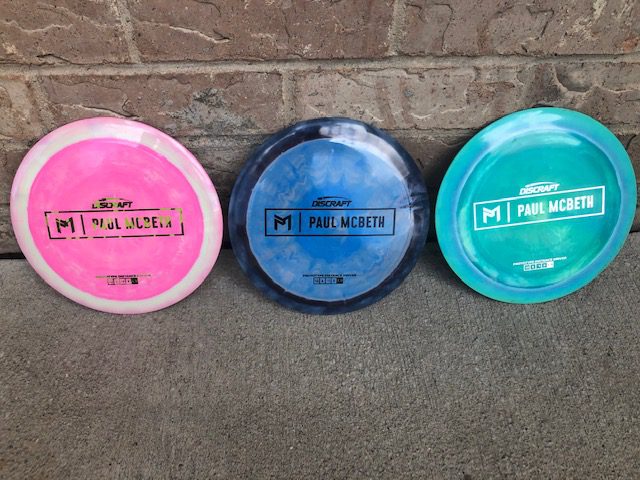
A Small, Elite Group
One of the obvious facts that jumps out at us when we look at the top selling and top rated discs is that there is not a variety of brands represented. Three companies make up the list of 13 molds that made it to the top. It’s rarely a surprise to see Innova and Discraft battle it out for the most molds at the top of any list. Each company had five molds on our list. What may be more surprising is the new kid on the block, Infinite Discs, claiming three spots on the list. Infinite’s oldest mold is still only a couple of years old. With its lineup of desirable flights and unique plastic blends, Infinite may be sitting at the top of the sales and ratings lists for a long time.
Covid-19 and Sales
Since the Covid shutdowns that have occurred around the world have affected supply chains at all levels, it would be crazy to say that it didn’t affect the sales numbers. While different manufacturers were affected to varying degrees, our list would most certainly look slightly different had the pandemic not occurred. In addition to supply lines being affected, sales were also affected, with people snapping up discs in unprecedented numbers. However, rather than try to dissect how each brand was affected and whether or not they were hurt or helped by the pandemic, we just presented the sales numbers for the year and made our top selections from the those numbers.
Tell Us What You Think.
Now it’s time for you to tell us about your favorite distance driver. Which is your top choice? Are the older, classic molds going to continue to stay at the top? Are the newer discs just hype, eventually fading into obscurity while the latest, greatest discs move up the sales charts? What about the smaller brands that are fighting for their share of the disc golf pie? Please take a few minutes to let us know which distance driver is number one for you. If your go-to distance driver is not on the list, let us know what it is.

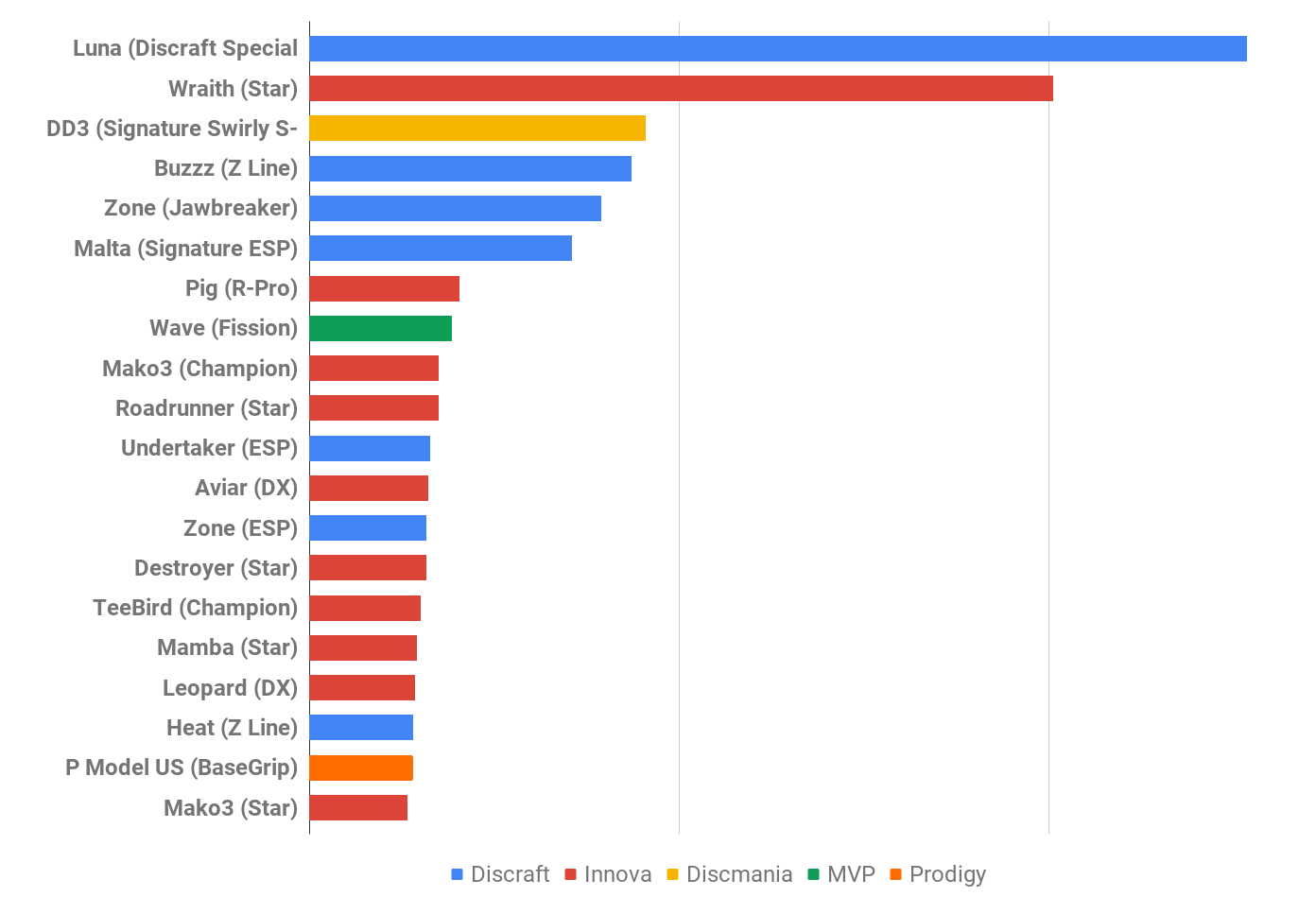
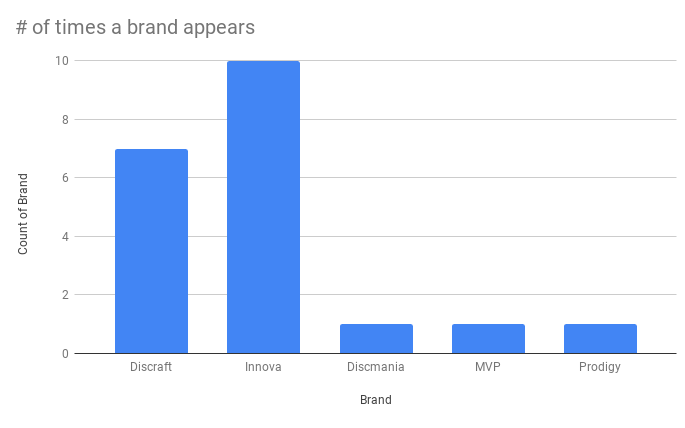


 The Harp is a very overstable approach putter. I’ve had great success flicking it, using it on hyzer throws, and for straight approaches. It is a trusty putt-and-approach disc that can handle some power. I’ve been throwing the Harp in BT Hard plastic which has some good grip to it and it can handle some tree hits and rough landings on rocks. Despite all the collisions I’ve put it through, I haven’t noticed much of a loss in the BT Hard Harp’s stability. This is a
The Harp is a very overstable approach putter. I’ve had great success flicking it, using it on hyzer throws, and for straight approaches. It is a trusty putt-and-approach disc that can handle some power. I’ve been throwing the Harp in BT Hard plastic which has some good grip to it and it can handle some tree hits and rough landings on rocks. Despite all the collisions I’ve put it through, I haven’t noticed much of a loss in the BT Hard Harp’s stability. This is a 